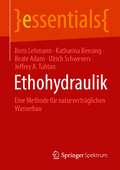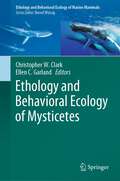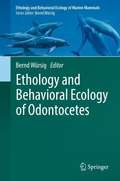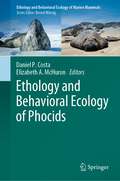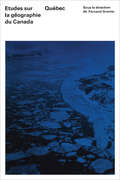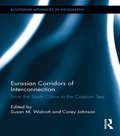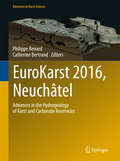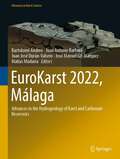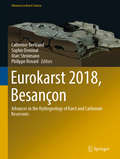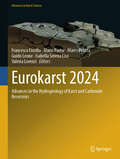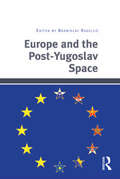- Table View
- List View
Ethohydraulik: Eine Methode für naturverträglichen Wasserbau (essentials)
by Beate Adam Boris Lehmann Ulrich Schwevers Katharina Bensing Jeffrey A. TuhtanEthohydraulik agiert an der Schnittstelle zwischen Verhaltensforschung (Ethologie) und dem Strömungsverhalten (Hydraulik). Ethohydraulische Untersuchungen helfen, das hydraulisch-reaktive Verhalten von Wassertieren zu verstehen. Aus den Befunden lassen sich Grenz- und Richtwerte sowie Gestaltungsvorgaben für die Planung wasserbaulicher Anlagen ableiten. In diesem essential geben die Autoren einen Überblick über die Grundlagen und methodischen Ansätze ethohydraulischer Untersuchungen. Zudem werden Einsatzbereiche und aktuelle Weiterentwicklungen aufgezeigt.
Ethology and Behavioral Ecology of Mysticetes (Ethology and Behavioral Ecology of Marine Mammals)
by Christopher W. Clark Ellen C. GarlandIn this book, an international team of leading marine mammal scientists, with a remarkably diverse set of backgrounds and areas of expertise, lead you through a synthesis of current knowledge on baleen whales. Baleen whales are the largest animals ever to have lived on this planet. They also have the lowest and most intense voices on Earth, most likely evolved to take advantage of ocean acoustic transmission conditions so as to be detectable across ocean basins. Some baleen whales can live to be 150-200 years old. They migrate many thousands of kilometers between feeding and breeding areas. They produce songs and calls that serve as behavioral foundations for establishing, maintaining and expanding their cultural identities. To conclude that we know the behavioral limits of these large brained, long-lived animals would be naïve. As baleen whale scientists, we are still beginning to comprehend the enormous complexities and natural histories of these remarkable animals.Today, the fact that whales sing is known throughout much of the world. This awareness started 50 years ago with the publication and popularization of a collection of humpback song recordings that motivated research into baleen whale behavioral ethology. In this book’s chapters, a reader’s experiences will stretch from learning about baleen whale laryngeal anatomy associated with their different voices to learning about the vast ocean areas over which their voices can be heard and the emerging complexities of their culturally defined societies. These are accompanied by chapters on the fundamental ethological contexts of socializing, migrating, and foraging. Two common themes permeate the book. One theme highlights the phenomenal increase in scientific knowledge achieved through technological advancements. The other theme recognizes the impacts of human-made activities on ocean acoustic environments and the resultant influences on the health and survival of individual whales and their populations. Although the book is intentionally ambitious in its scope, as scientists, we fully recognize that baleen whale science is still in its infancy. Many profound revelations await discovery by cohorts of young, multi-talented explorers, some of whom are stretching their wings in this volume and some of whom are reading these scientific stories for the first time.
Ethology and Behavioral Ecology of Odontocetes (Ethology and Behavioral Ecology of Marine Mammals)
by Bernd WürsigThis book concentrates on the marine mammalian group of Odontocetes, the toothed whales, dolphins, and porpoises. In 23 chapters, a total of 40 authors describe general patterns of ethological concepts of odontocetes in their natural environments, with a strong bent towards behavioral ecology. Examples are given of particularly well-studied species and species groups for which enough data exist, especially from the past 15 years. The aim is to give a modern flavor of present knowledge of ethology and behavior of generally large-brained behaviorally flexible mammals that have evolved quite separately from social mammals on land. As well, the plight of populations and species due to humans is described in multiple chapters, with the goal that an understanding of behavior can help to solve or alleviate at least some human-made problems.
Ethology and Behavioral Ecology of Otariids and the Odobenid (Ethology and Behavioral Ecology of Marine Mammals)
by Claudio Campagna Robert HarcourtThis book is focused on the marine mammalian groups the Otariidae and the Odobenidae, otherwise known as fur seals, sea lions and the walrus. In 30 chapters, more than 60 authors from 30 institutions and 13 nationalities, discuss a broad suite of topics from maternal care and mating behavior, through play, cognition and personality, to adaptation to life in the Anthropocene. The authors explore the behaviors that have allowed these semi-aquatic mammals to thrive in the marine realm. Many populations have recovered following historical decimation, with interesting evolutionary consequences which are explored. Detailed, selected, individual species descriptions are also provided, showcasing the behavioral diversity of this engaging, adaptive and highly successful group of marine mammals.
Ethology and Behavioral Ecology of Phocids (Ethology and Behavioral Ecology of Marine Mammals)
by Daniel P. Costa Elizabeth A. McHuronPhocid (or earless or true) seals are ecologically diverse, occupying habitats from the tropics to the poles in marine and freshwater and feeding on anything from tiny zooplankton to other marine mammals. There are 18 species of phocid seals, the smallest species (ringed seal) is more than 20 times smaller than the largest (southern elephant seal), with marked sexual dimorphism present in some species. This book examines the behavior, ecology, and physiology that allow phocid seals to inhabit such a wide range of habitats. The book is composed of 16 chapters written by 37 authors from 8 countries. The book first describes the general patterns of phocid behavior, followed by descriptions of what is known about well-studied species. We have taken a holistic approach, focusing not only on the behaviors themselves but also on the factors that constrain the expression of behavior and the proximate mechanisms driving behavior. In many cases, the chapters represent collaborations between well-established researchers and early-mid career individuals who bring new perspectives to help carry the field of phocid behavioral ecology well into the future.
Ethology and Behavioral Ecology of Sea Otters and Polar Bears (Ethology and Behavioral Ecology of Marine Mammals)
by Randall W. Davis Anthony M. PaganoSea otters and polar bears are carnivorous marine mammals that still resemble their terrestrial ancestors. Compared with Cetacea (whales and dolphins), Sirenia (dugongs and manatees), and Pinnipedia (seals, sea lions, and walrus), they are less adapted for an aquatic life and the most recently evolved among marine mammals. Sea otters are amphibious but seldom come ashore, and polar bears primarily occur on sea ice or along the shore. When at sea, both species spend most of their time swimming at the surface or making short, shallow dives when foraging or pursuing prey. Indeed, polar bears rarely pursue seals in water. Nevertheless, polar bears are powerful swimmers and will stalk seals from the water. As with many other large carnivores, they are solitary hunters. Although sea otters are gregarious and form aggregations at sea called rafts, they are primarily asocial. Except during mating, the principal interaction among sea otters occurs between a female and offspring during the six-month dependency period. In large carnivores (e.g., wolves and lions) that feed on ungulates, sociality and cooperation are favored because of the need to capture large prey and defend carcasses. Polar bears, which are the largest terrestrial carnivore, are solitary hunters of seals and are neither gregarious nor social. Males and females briefly associate during courtship and mating. During this time, males aggressively compete for females. At other times, males generally avoid each other except for aggregations of males that form while summering on land, and females with cubs avoid males, which are known for infanticide. As with sea otters, the interaction of polar bears outside of mating occurs between a female and her offspring during the 2-3 year dependency period. This interaction is critically important when altricial cubs are born in the winter den. This book provides new insight into the ethology and behavioral ecology of sea otters and polar bears. Each chapter reviews the discoveries of previous studies and integrates recent research using new techniques and technology. The authors also address historic and current anthropogenic challenges for their survival as climate change alters entire marine ecosystems.
Ethology and Behavioral Ecology of Sirenia (Ethology and Behavioral Ecology of Marine Mammals)
by Helene MarshDespite their rich fossil history, there are only four surviving species of sirenians or sea cows, the only fully aquatic herbivorous mammals. The three species of manatees and the dugong live in the coastal waters rivers and lakes of more than 80 tropical and subtropical countries and are all on the IUCN Red List of Threatened Species. This book examines sirenian conservation biology through the lens of their behavioral ecology and ethology. Sirenian feeding, diving, movement, social and reproductive behaviors are reviewed by an international team of scientists from eight countries, with an emphasis on data gathered in the past 15 years.
Etudes sur la Geographie du Canada
by Fernand GrenierThe publication of the series, 'Studies in Canadian Geography,' by the organizers of the 22nd International Geographical Congress, introduces to the international community of geographers a new perspective of the regional entities which form this vast countries. These studies should contribute to a better understanding among scholars, students, and the people of Canada of the geography of their land. Geographical works embracing the whole of Canada, few in number until recently, have become more numerous during the last few years. This series is original in its purpose of re-evaluating the regional geography of Canada. In the hope of discovering the dynamic trends and the processes responsible for them, the editors and authors of these volumes have sought to interpret the main characteristics and unique attributes of the various regions, rather than follow a strictly inventorial approach. In preparing this volume on Quebec, the contributors have looked at the evolution and present patterns of the ecumene of southern Québec, rural and urban Québec, and the dynamic biogeography of Québec.
Eurasia: World Boundaries Volume 3 (World Boundaries Series #Vol. 3)
by Carl Grundy-WarrEurasia offers a wide-ranging and original interpretation of territory, boundaries and borderlands in Europe, Asia and the Far East. This forms part of a unique series of books focussing on world boundaries which embrace the theory and practice of boundary delimitation and management, boundary disputes and conflict resolution, and territorial change in the new world order.
Eurasian Arctic Land Cover and Land Use in a Changing Climate
by Garik Gutman Anni ReissellThis volume is a compilation of studies on interactions of land-cover/land-use change with climate in a region where the climate warming is most pronounced compared to other areas of the globe. The climate warming in the far North, and in the Arctic region of Northern Eurasia in particular, affects both the landscape and human activities, and hence human dimensions are an important aspect of the topic. Environmental pollution together with climate warming may produce irreversible damages to the current Arctic ecosystems. Regional land-atmosphere feedbacks may have large global importance. Remote sensing is a primary tool in studying vast northern territories where in situ observations are sporadic. State-of-the-art methods of satellite remote sensing combined with GIS and models are used to tackle science questions and provide an outlook of current land-cover changes and potential scenarios for the future. Audience: The book is a truly international effort involving U.S. and European scientists. It is directed at the broad science community including graduate students, academics and other professionals in this field.
Eurasian Business and Economics Perspectives: Proceedings of the 47th Eurasia Business and Economics Society Conference (Eurasian Studies in Business and Economics #34)
by Mehmet Huseyin Bilgin Hakan Danis Ender Demir Manuela ZipperlingThis proceedings book is the 34th issue of the Springer&’s series Eurasian Studies in Business and Economics, which is the official book series of the Eurasia Business and Economics Society. This book includes selected papers presented at the 47th EBES Conference—Berlin—on April 18–20, 2024, hosted by FOM University of Applied Sciences, Berlin, Germany. In the conference, 229 papers by 458 colleagues from 52 countries were presented. The conference was held hybrid with both, in-person and online paper presentation formats.
Eurasian Cities: New Realities along the Silk Road
by Charles Kunaka Souleymane Coulibaly Uwe Deichmann William R. Dillinger Marcel Ionescu-Heroiu Ioannis N. Kessides Daniel SaslavskyThis report responds to pressing questions for policymakers in Eurasian cities and national governments. Faced with changing economic circumstances and a reorientation of trade toward Europe and Asia, will Eurasia's cities be able to adjust? Will some cities be granted the flexible regulations and supportive policies necessary for growth? And will some be permitted to shrink and their people assisted in finding prosperity elsewhere in the region?Even as Eurasian cities diverge, they face shared challenges. Policymakers have a key role in assisting spatial restructuring, particularly in addressing imperfect information and coordination failures. They can do so by rethinking cities, better planning them, better connecting them, greening them and finding new ways to finance these changes. Eurasian cities will also have to find the right balance between markets and institutions to become sustainable. As the World Development Report 2009: Reshaping Economic Geography illustrates, Eurasia (excluding Russia) is a 3D region- a region with low density, long distance, and many divisions. Securing accessibility to leading regional markets such as China, India, and Russia is thus critical. This will require key institutions to be developed to unite the countries, key connective infrastructures to be established between domestic and regional markets, and targeted interventions to be undertaken to compensate countries for short-term losses from this deepened economic integration. Policymakers at the highest levels in these countries should put accessibility at the top of their agendas.
Eurasian Corridors of Interconnection: From the South China to the Caspian Sea (Routledge Advances in Geography #10)
by Corey Johnson Susan M. WalcottConnectivity, as well as conflict, characterizes Eurasia. This edited volume explores dynamic geopolitical and geo-economic links reconfiguring spaces from the eastern edge of Europe through the western edge of Asia, seeking explanation beyond description. The ancient Silk Road tied together space, much as pipelines, railroads, telecommunications infrastructure, and similar cultural and constructed links ease the mobility of people and products in modern Eurasia. This book considers Eurasia along an interlinked corridor, with chapters illustrating the connections as a discussion foundation focusing on the shared interactions of a set of nation states through time and across space, generating more positive considerations of the resurgently important region of Eurasia. China’s interests fall into three chapters: the southeastern border with Vietnam, the southwestern Himalayan edge, and the western Muslim regions. Russia’s recovery relates events to a larger landmass context and focuses on the importance of historic mobility. A geo-history of the Caspian considers this petroleum-rich area as a zone of cultural and economic interconnection. The final focus on Central Asia treats the traditional heart of “Eurasia”. The concluding chapter pulls together strands linking subregions for a new concept of “Eurasia” as an area linked by vital interests and overlapping histories.
Eurasian Steppes. Ecological Problems and Livelihoods in a Changing World
by Marinus J.A. Werger Marja A. van StaalduinenSteppes form one of the largest biomes. Drastic changes in steppe ecology, land use and livelihoods came with the emergence, and again with the collapse, of communist states. Excessive ploughing and vast influx of people into the steppe zone led to a strong decline in nomadic pastoralism in the Soviet Union and China and in severely degraded steppe ecosystems. In Mongolia nomadic pastoralism persisted, but steppes degraded because of strongly increased livestock loads. After the Soviet collapse steppes regenerated on huge tracts of fallow land. Presently, new, restorative steppe land management schemes are applied. On top of all these changes come strong effects of climate change in the northern part of the steppe zone. This book gives an up-to-date overview of changes in ecology, climate and use of the entire Eurasian steppe area and their effects on livelihoods of steppe people. It integrates knowledge that so far was available only in a spectrum of locally used languages.
Eurasia’s Maritime Rise and Global Security: From The Indian Ocean To Pacific Asia And The Arctic (Palgrave Studies in Maritime Politics and Security)
by Geoffrey F. GreshThis book explores Eurasia’s growing embrace of its maritime geography from the Indian Ocean to Pacific Asia and the Arctic. In an age of climate change, the melting of the Arctic will transform Eurasia’s importance, in addition to influencing the political, economic, and military dynamics across Eurasia’s main maritime regions. These emerging shifts have already begun to alter maritime trade and investment patterns, and thus the global political economy. It also creates a rising threat to the current status quo of world order that has long been dominated by the Atlantic World. This edited volume showcases some of the world’s leading experts and examines Eurasia from a saltwater perspective, analyzing its main maritime spaces in a threefold manner—as avenue, as arena, as source—to show the significance of this geostrategic change and why it matters for the future of the world’s oceans.
EuroKarst 2016, Neuchâtel
by Catherine Bertrand Philippe RenardThis book presents the latest advances in the field of karst hydrogeology and carbonate reservoirs. These include, but are not limited to: geomorphology of karst, flow and solute transport in karst; innovative metrology; modelling; speleogenesis and geology of carbonate reservoirs; deep reservoir exploration and production; water management and protection in karst environments; contaminant migration and chemical behavior; hydrochemistry and regional aquifer studies. EuroKarst offers a platform for professional exchanges between field practitioners and academic researchers. It is the European biennial conference on the hydrogeology of karst and carbonate reservoirs. It is organized every two years by the Universities of Neuchâtel (Switzerland), Besançon (France), and Malaga (Spain).
EuroKarst 2022, Málaga: Advances in the Hydrogeology of Karst and Carbonate Reservoirs (Advances in Karst Science)
by Bartolomé Andreo Juan Antonio Barberá Juan José Durán-Valsero José Manuel Gil-Márquez Matías MudarraThis book covers advances in the field of karst from a variety of perspectives to facilitate knowledge and promote interaction between disciplines. New methods are addressed that advance data collection, analysis, and interpretation in a wide range of karst contexts. Case studies are presented to provide examples of advancing science. Issues addressed include karst hydrogeology (water resources assessment, groundwater pollution and protection), methods to study karst aquifers (based on hydrodynamic, hydrochemistry, isotopes, dye tracing, geophysical surveys, and modeling techniques), karst geomorphology and landscape, mining and engineering in karst media (tunnels, dams, etc.), and karst cavities (touristic caves, natural heritage). This book is a resource for scientists around the world to compare problems, results, and solutions. Likewise, the examples included are used in policy decision making in karst regions. Finally, the contributions are used as a tool for university teaching.
Eurock 2006: Proceedings of the International Symposium of the International Society for Rock Mechanics, Eurock 2006, Liege, Belgium, 9-12 May 2006
by Jean-François Thimus Robert Charlier Alain Van Cotthem Jean-Pierre TshibanguSpecial emphasis is given to the constitutive behaviour of rock material, including rock mechanics and partial saturation, chemo-mechanics, thermo-hydro-mechanics, weathering and creep. Theoretical concepts, laboratory and field experiments and numerical simulations are discussed. Multiphysics coupling and long-term behaviour has practical applicat
Eurocode-Compliant Seismic Analysis and Design of R/C Buildings
by Ioannis Avramidis Asimina Athanatopoulou Konstantinos Morfidis Anastasios Sextos Agathoklis GiaralisThis book aims to serve as an essential reference to facilitate civil engineers involved in the design of new conventional (ordinary) reinforced concrete (R/C) buildings regulated by the current European EC8 (EN 1998-1:2004) and EC2 (EN 1992-1-1:2004) codes of practice. The book provides unique step-by-step flowcharts which take the reader through all the required operations, calculations, and verification checks prescribed by the EC8 provisions. These flowcharts are complemented by comprehensive discussions and practical explanatory comments on critical aspects of the EC8 code-regulated procedure for the earthquake resistant design of R/C buildings. Further, detailed analysis and design examples of typical multi-storey three-dimensional R/C buildings are included to illustrate the required steps for achieving designs of real-life structures which comply with the current EC8 provisions. These examples can be readily used as verification tutorials to check the reliability of custom-made computer programs and of commercial Finite Element software developed/used for the design of earthquake resistant R/C buildings complying with the EC8 (EN 1998-1:2004) code. Th is book will be of interest to practitioners working in consulting and designing engineering companies and to advanced undergraduate and postgraduate level civil engineering students attending cours es and curricula in the earthquake resistant design of structures and/or undertaking pertinent design projects.
Eurokarst 2018, Besançon: Advances in the Hydrogeology of Karst and Carbonate Reservoirs (Advances in Karst Science)
by Catherine Bertrand Philippe Renard Sophie Denimal Marc SteinmannThis book presents selected papers from the EuroKarst 2018 conference, which highlighted the latest advances in the field of Karst Hydrogeology and Carbonate Reservoirs. The event attracted more than 180 participants. From among their contributions, the papers were selected and subsequently reviewed by the scientific committee to ensure the highest possible quality.
Eurokarst 2024: Advances in the Hydrogeology of Karst and Carbonate Reservoirs (Advances in Karst Science)
by Mario Parise Francesco Fiorillo Marco Petitta Guido Leone Isabella Serena Liso Valeria LorenziThis book covers advances in the field of karst from a variety of perspectives to facilitate knowledge and promotes interaction between disciplines. New methods are addressed that advance data collection, analysis, and interpretation in a wide range of karst contexts. Case studies are presented to provide examples of advancing science. Issues addressed include karst hydrogeology (water resources assessment, groundwater pollution and protection), methods to study karst aquifers (based on hydrodynamic, hydrochemistry, isotopes, dye tracing, geophysical surveys, and modelling techniques), karst geomorphology and landscape, mining and engineering in karst media (tunnels, dams, etc.), and karst cavities (touristic caves, natural heritage). This book is a resource for scientists around the world to compare problems, results and solutions. Likewise, the examples included can be used in policy decision making in karst regions. Finally, the contributions can be used as a tool for university teaching.
Europe and the Post-Yugoslav Space
by Branislav RadeljićCharting the path from intervention to integration Europe and the Post-Yugoslav Space examines the role of Europeanization on the development of the countries of the former Yugoslavia. Slovenia, Croatia, Macedonia, Montenegro, Serbia, Bosnia and Herzegovina and Kosovo may have a shared history but their experiences, views and attitudes to European integration vary dramatically. Opinion within each state is often equally as keenly divided as to the benefits of active membership. The debate within each country and their comparative differences in approach provide fascinating case studies on the importance and relevance of the EU and the effectiveness of Europeanization. A wide range of contributors with significant experience gained within the EU as well as their country of origin use their expert understanding of the language and cultures of the countries concerned to provide detailed and rich insights into the troubled history and potential of the post-Yugoslav space.
Europe's Changing Geography: The Impact of Inter-regional Networks (Regions and Cities #65)
by Nicola Bellini Ulrich HilpertEuropean macro-regions, Euroregions and other forms of inter-regional, cross-border cooperation have helped to shape new scenarios and new relational spaces which may generate opportunities for economic development, while redefining the political and economic meaning of national borders. This book is based on a number of key case studies which are crucial to understanding the complex web of political, economic and cultural factors that shape the heterogeneous picture of Europe’s new geography. This book provides a fresh view on this phenomenon, with a realistic approach shedding light on its complexity as well as on its ambiguities. The new macro-regions are interpreted with an approach recognizing the importance of institutionalization, but also their flexible configuration and "blurred" borders. The book also raises the issue of credibility and legitimacy, arguing that inter-regional cooperation has to be removed from the foggy realm of the exchanges between local political and bureaucratic elites in order to be clearly and concretely motivated, and functional to key strategic objectives of the regions. Finally, the authors suggest a complementarity between relations based on proximity and wider (possibly global) networks where some territories, and especially metropolises, find opportunities based on "virtual" proximity. Europe's Changing Geography provides a substantial re-appraisal of a key phenomenon in the process of European integration today. It will be of interest both to scholars of the political economy of European regionalism and to practitioners.
Europe's Early Fieldscapes: Archaeologies of Prehistoric Land Allotment (Themes in Contemporary Archaeology)
by Robert Johnston Stijn Arnoldussen Mette LøvschalThis volume focuses on the development of field systems through time and space and in their wider landscape context, including classical issues pertaining to past land use and management regimes, including manuring, water, land and crop management, and technologies such as slash‐and‐burn cultivation, and use of the ard and plough. This book provides the first comprehensive attempt to bring together and provide a comprehensive insight into the latest prehistoric fieldscape research across Europe. The book raises a broader awareness of some of the main questions and scientific requests that are addressed by scholars working in various fieldscapes across Europe. Themes addressed in this book include (a) mapping and understanding field system morphologies at various scales, (b) the extraction of information on social processes from field system morphologies, (c) the relations between field systems and cultural and natural features of their environment, (d) time-depths and temporalities of usage, and (e) specifics of the underlying agricultural systems, with special attention to matters of continuity and resilience and relation to changing practices. The case-studies explore how to best approach such landscapes with traditional and novel methodologies and targeted research in order to enhance our knowledge further. The volume offers inspiration and guidance for the heritage management of fieldscape heritage – not solely for future scholarly research but foremost to stimulate strategic guidance to frame and support improved protection of evidently vulnerable resources for Europe’s future. This volume is of interest to landscape archaeologists.
